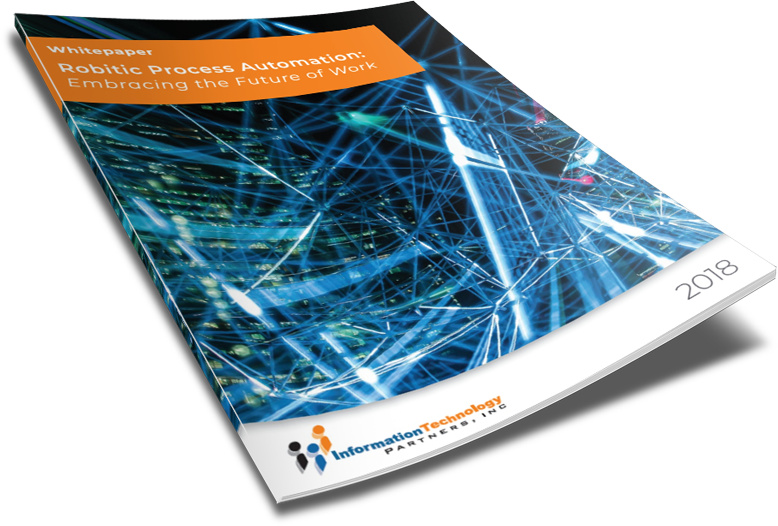TAKE NOTE (Insights and Emerging Technology)

The Army’s logistics and finance business systems are reaching their end of life, putting us at a crossroads for the next phase of modernization—and it’s coming via Enterprise Business Systems – Convergence. Technology upgrades on the battlefield equip today’s military to fight and win. The time is now to also modernize the Army’s support structure, including enterprise sustainment systems that enable force readiness and lethality.
Many of you may be familiar with the Army Unified ERP program recently won by Accenture. Accenture won the contract with a $787.7 million bid in late 2019 for unifying the sustainment of Army ERP systems.
You may not be aware of Army EBS Convergence (EBS-C) which is focused on transforming the way our Army does business entirely.
Globally, the Army has more than 190,000 users on its logistics and financial management enterprise resource planning (ERP) systems. Every day, hundreds of thousands of Soldiers and civilians process 75 million business transactions, managing hundreds of billions of dollars in assets. These platforms interact with and impact every aspect of the Army’s business operations, from ordering supplies in theater to supporting maintenance activities in garrison.
However, Army believes the business systems they currently use—while state of the art for their time in the early 2000s—will soon reach their end of life and become unsustainable.
That is why, in March 2020, the undersecretary of the Army approved a modernization effort called Enterprise Business Systems – Convergence (EBS-C), which is focused on transforming the way Army does business.
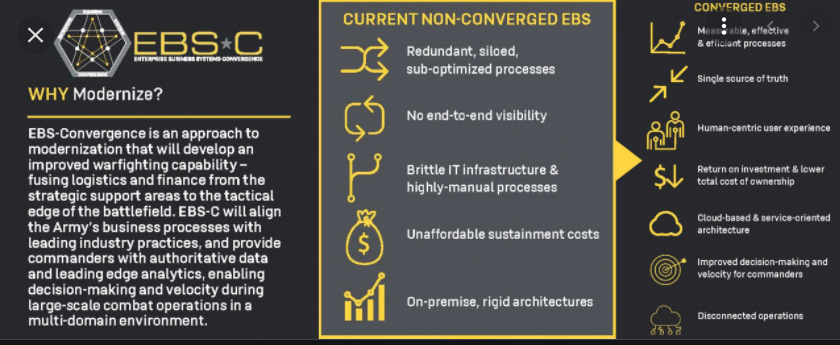
EBS-C is necessary because the Army’s current enterprise business systems are not able to efficiently drive readiness, nor do they provide modern capabilities to execute sustainment or fiscal management operations.
For example, one system manages the procurement of parts and associated costs using process A, while another tracks procurement and costs using process B. While the systems talk to each other, they are not completely speaking the same language or tracking things the same way, which affects reporting, inventory, cost management and more. Modernizing Army business systems to track and manage things the same way, in the same “language,” in the same system will streamline sustainment and finance business processes to increase velocity and fidelity of decisions on the battlefield.
Hang on, EBS-C aims to initially converge six of the Army’s major ERPs, including:
- General Fund Enterprise Business System (GFEBS), the Army’s largest finance and accounting system.
- GFEBS-Sensitive Activities, the sensitive activities component of GFEBS.
- Global Combat Support System – Army, which supports logistical and tactical management of Army assets.
- Logistics Modernization Program, which facilitates national supply chain management of parts and equipment.
- Army Enterprise Systems Integration Program Hub, the system for master data management.
- Headquarters Army Environmental System, which provides environmental data management and reporting.
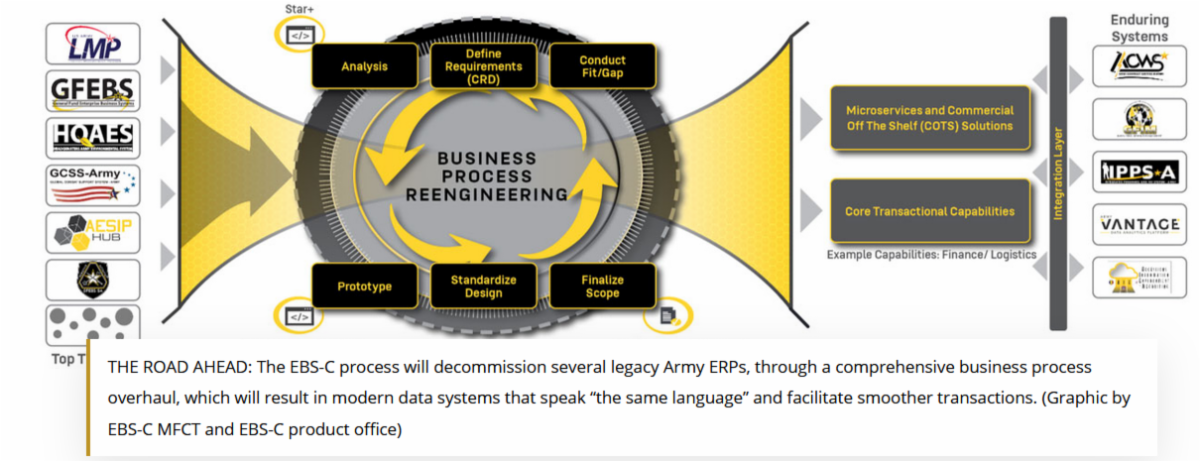
By 2027, the Army will deploy the converged system, fusing six missions into one, to manage everything from ordering and delivering tank and helicopter parts, to managing costs, to combining and sharing the data needed to win on the battlefield.
To get there, the Army will leverage the capabilities of the private sector to support in the deployment, development and integration of the system. In February 2021, the MFCT and the EBS-C PMO hosted their first industry day. More than 500 industry participants attended virtually to hear how the Army plans to partner with the commercial sector on this significant transformation project.
The pathway to this converged system includes an approach that is “as commercial as possible and as military as necessary,” meaning that Army must reap the benefits of industry best practices while providing solutions for military purposes.
Interested in learning more about RPA? Download our FREE White Paper on “Embracing the Future of Work”
UNDER DEVELOPMENT (Insights for Developers)
COMPOSABLE ERP: WHAT IT IS AND WHY IT’S IMPORTANT PART 1
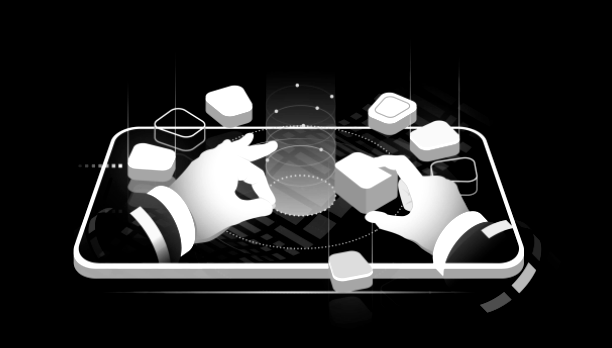
Intro
Enterprise resource planning applications (ERPs) have routinely missed the mark in multiple ways. They have failed on the ability to plan, design and execute with real-time responsiveness. As an example, end of month processing often includes five to seven days to close the books, then another day or two to run the financial statements. The user experience (UX) of ERP often falls short of customer, employee and supplier expectations, which has led SAP to release SAP Personas and Fiori design. And what about customization? If you have been around as longs as me (I started in SAP 2.2g in 1994), you have seen the how innovation, delivery, and adaptability have been non-existent due to the SAP core being riddled with customization.
OK, OK, I can hear you saying Tony WTF is Composable ERP? I mean I am laughing along with you… BUT there may be something to this so I am asking for a few conciliation’s. First you can see this will be in parts, two specifically. So hang in there and read both parts. Second, please suspend your suspicion long enough to allow what I am saying to seep in. Thanks in advance for this and lets get started!
Before I can talk about the latest vision of “Composable ERP”, I need to go back to about 2014 and lay some ground work in what back then was called “PostModern ERP”. Stop laughing….
POSTMODERN ERP DEFINED
The “postmodern” ERP system, defined by Gartner in 2014 as:

The goal of a postmodern ERP strategy is to use the best applications possible in each particular area, while ensuring they adequately integrate with each other when necessary. These systems may be hosted either on-premise or in the cloud, based on the organization’s needs.
So how does this work exactly? For example, an organization might prefer to use a more robust industry-standard CRM system, such as Salesforce (which can integrate with most major ERP suites), instead of the CRM application bundled with their ERP system.
THE POSTMODERN ERP STRATEGY
The linchpin of post modern ERP strategy is that it is not one highly defined, universal approach; it’s not necessarily a unified “system” you can buy from a vendor. Two similar organizations’ strategies could both be “postmodern,” yet still be wildly different from each other.
Broadly speaking, a postmodern approach actually includes two or more separate strategies—one for each category of applications the organization uses. According to Gartner, most ERP applications can be broken down into either the “administrative” or the “operational” category:
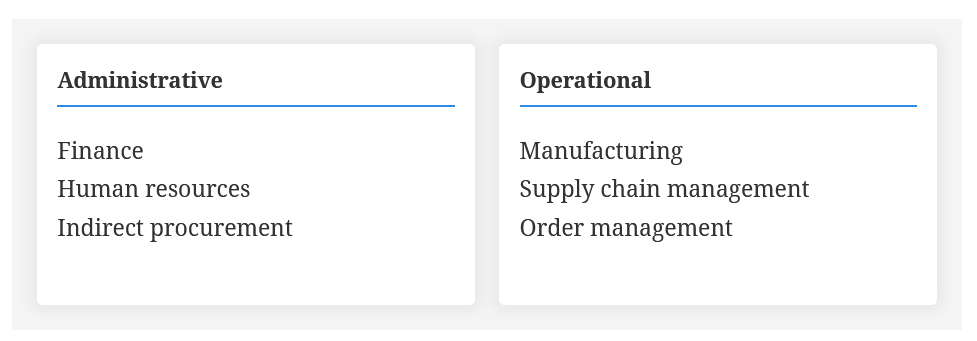
Enterprises need to identify an appropriate and distinct strategy for each category of applications they use, rather than using the monolithic strategy of a traditional ERP implementation. Thus, a postmodern ERP system will likely be comprised of applications from two or more vendors, and may include multiple deployment models.
Here is an example of what a postmodern ERP strategy might look like…
– Dig Deeper –
What is EBS Convergence
Q&A (Post your questions and get the answers you need)

Q. What is SAP Business Technology Platform (BTP)? How is it different than SAP Cloud Platform (SCP)?
A. At the SAP RISE announcement event not only the new RISE offering was introduced. A change in product naming and positioning was performed as well. SAP dropped the word “cloud” in the name SAP Cloud Platform (SCP). The new name is SAP Business Technology Platform (BTP). No big news here as we are used to seeing SAP constantly changing names and BTP was already part of SAP wording before SAP TechEd ‘20
Is BTP just a new name for SCP? No! And that is very good news. SAP not only changed the name to BTP, it widens the scope of their cloud offerings to match more what customers expect from SAP. BTP is more than “just” cloud. It includes all the technology SAP offers to enable the intelligent enterprise.
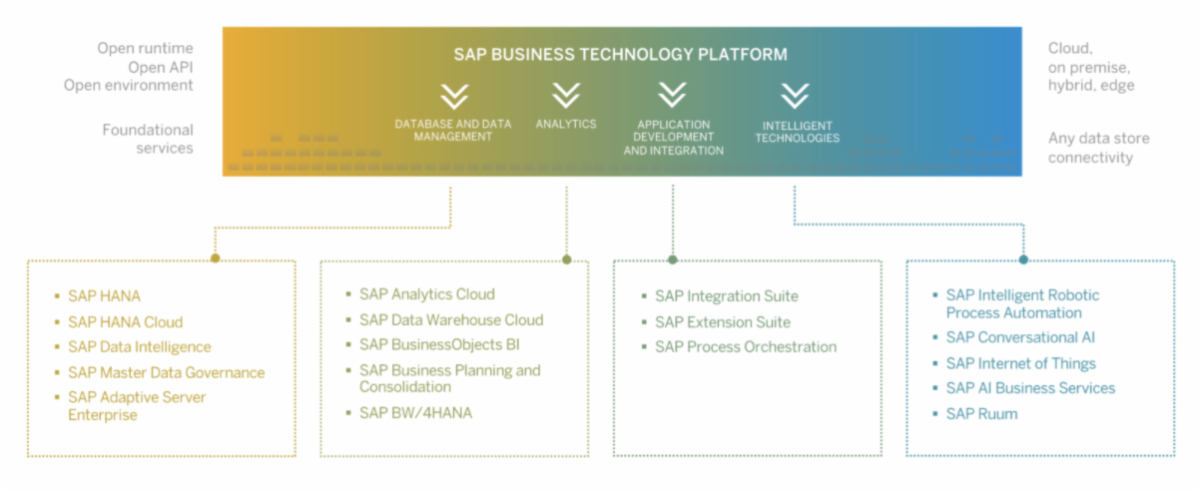
As you can see in the picture above, BTP includes SCP services and related products like SAP HANA, SAP Analytics Cloud, ASE, MDG, BW, BI, etc. Under the new name you get now more than with the old SCP. This makes 100% sense, as customers can now find under BTP cloud services as well as products that add value when combined together.
This should make it easier for SAP to talk to customers and explain the intelligent enterprise story end to end – not process-wise, but technology-wise. The separation we had until now is gone. Instead of asking if SAC is part of SCP, it is now clearer they are all under the same strategy (intelligent enterprise), serve different areas (DB, apps, AI) and are meant to be used together (BTP).
Cheers!


